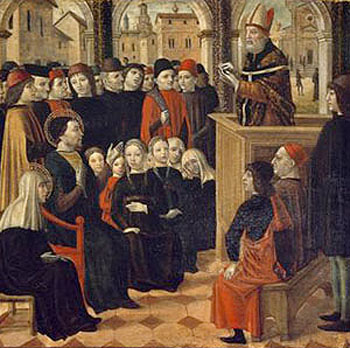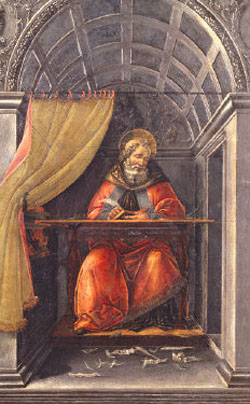 |
Catholic Customs
A Study of the Veil in the Christian Tradition - Part 3
St. Ambrose & St. Augustine on the Veil
Donald P. Goodman III
3. 2 St. Ambrose of Milan
St. Ambrose of Milan spoke indirectly on the importance of the veil. He did say enough about modesty to establish his opinion of its importance. The saint wrote Concerning Virgins, a treatise in which he discussed various aspects of perpetual virginity in the early Church. In it he condemned many deeds of immodesty, one of which has a bearing upon the veil.

St. Ambrose Preaching - Ambrogio Bergognone |
Using very strong language St. Ambrose declared that casting off the veil is an act of lust and immodesty:
“Is anything so conducive to lust as with unseemly movements thus to expose in nakedness those parts of the body which either nature has hidden or custom has veiled, to sport with the looks, to turn the neck, to loosen the hair? Fitly was the next step an offense against God. For what modesty can there be? ” (1)
There are a number of points which can be observed on the face of St. Ambrose’s words, most importantly for our discussion that “to loosen the hair” is “to expose in nakedness” parts which ought to be concealed. What does he mean, however, by “to loosen the hair?” Simply that hair ought to be bound?
St. Ambrose’s description bears a strong similarity to St. John Chrysostom’s precept that the hair ought to “be carefully wrapped up on every side.” (2) If the hair is, as St. John commands, carefully wrapped up, then, it would seem that to unveil it would indeed be to loosen it. I think that St. Ambrose is indirectly referring to the veil in this statement, and condemning the removal of it as a sin of immodesty and probably also of lust.
He also uses very strong language concerning the act of unveiling, describing it as “to expose in nakedness.” As we will see, St. Augustine, the great student of St. Ambrose, describes the removal of the veil in the same way, (3) as a stripping or denuding of what ought properly to be there. St. Ambrose’s words are strong indeed, and ought to give us moderns pause before condemning them as simply overzealous.
Now, I turn to the great student of St. Ambrose, St. Augustine of Hippo, the prince of the patristic age, so admired by St. Thomas Aquinas, the Angelic Doctor . What were St. Augustine’s words and thoughts on the veil? Was it important in his Christian world?
3. 3 St. Augustine of Hippo
In the vast literary production of St. Augustine, I only found two places in which he mentions the veil, and both times he stressed its importance. Once, in a letter he wrote very quickly to Possidius, a fellow priest; again, in his treatise On Holy Virginity. In both instances, the great saint did not in any way mince words.

St. Augustine Writing in his Study
Sandro Boticelli |
In his treatise On Holy Virginity, St. Augustine was chiefly speaking on virginity and its accompanying duties. At one point, he made a general conclusion about a certain behavior regarding wearing the veil, which seems to apply to all women universally, not just to virgins.
The saint discussed the pride of some virgins who break the rules of Christian modesty for the sake of “a certain aim of pleasing, either by more elegant dress than the necessity of so great profession demands, or by remarkable manner of binding the head, whether by bosses of hair swelling forth, or by coverings so yielding, that the fine net-work below appears: unto these we must give precepts, not as yet concerning humility, but concerning chastity itself, or virgin modesty.” (4)
It seems to me that in this text St. Augustine describes any failure in the veil to conceal all the hair, even a minor one, as a violation of chastity. I see him condemning those who use a “remarkable manner of binding the head,” language quite similar to St. Ambrose (who referred to women who “loosen the hair”), as unchaste. (5) It is important to remember when gauging the role of the veil in early Catholic society that St. Augustine is not condemning women who cast off the veil; he is condemning women who wear veils that allow the hair to come out around the edges or that are so thin that “the fine net-work below,” the hair, shows through. It seems clear that St. Augustine had a very strong view on the importance of the veil, and would not allow compromise about it.
Furthermore, St. Augustine’s condemnation gives an indication about the prevalence of the veil in early Catholic society. In any society in which a given practice is in the minority, but which that minority is trying to extend, it is likely that the practice will remain pure and unaltered, at least during the period of its extension to universality within the culture. The veil custom, however, had not been maintained pure; various abuses had crept into the practice, and these abuses were prevalent enough that St. Augustine felt the need to condemn them. This indicates that the veil was an already established custom that St. Augustine was trying to restore to its original purity, rather than a new custom that he was trying to implant in his Diocese. If the veil had become established so early in the Christian era, it must have been considered of some importance by the early Christians.
St. Augustine also mentioned the veil in a letter he wrote to his brother priest, Possidius. He was discussing the general role of vanity in the choosing of women’s dress, and, as one might expect, condemning it. He did mention, however, that some people have good reason to dress more elaborately than others; in this context, the veil comes into the discussion. The Doctor of Grace told us:
“Those who are of the world think how they are to please their wives, if they are men, or their husbands, if they are women, [and choose their dress accordingly]; except that women, whom the Apostle orders to cover [velare, to veil] their heads, ought not to uncover their hair, even if they are married.” (6)
St. Augustine did not make any exceptions, any more than St. John Chrysostom did; he prescribed the wearing of the veil for all women at all times, whether married or not. The Latin-reading reader will notice the word which the Saint uses for “uncover”: nudare, a pejorative word meaning “to strip” or “to make naked,” or even “to spoil” or “to plunder.” St. Augustine clearly takes a very strong view of women “stripping” their heads and “making naked” their hair, and consequently he must take a strong view about the importance of maintaining the sign of authority over woman’s head, the veil, the covering which conceals the woman’s nakedness.
3. 4 Conclusion
It seems clear that the Fathers felt that removing a woman’s veil was, in a large sense, making her “naked,” stripping her of something that is vital for her real well-being. For it is, indeed, woman’s own well-being with which the Fathers were concerned; it is for her good that she ought to wear the veil, just as it is for man’s good that he not wear it. It is not a matter of enslavement and liberation, but of proper and improper place.
|
St. John Chrysostom
|
St. Ambrose
| St. Augustine
|
| (ir) 2-4 Scope |
All the hair
|
All the hair
| All the hair |
| Time |
At all Times
|
At all time
|
At all times |
| Reasons |
Div. anal.; lust |
Lust
|
Div. anal.; lust |
| Verse 16 |
Still bound
|
|
|
Table 2: The Veil and the Fathers: A Summary of Doctrine
The mentioned Fathers – St. John Chrysostom, St. Ambrose and St. Augustine –believed very strongly that God designed the world in a particular way, and that each person or thing has its appointed place, women not excepted. The veil was a visible reminder of woman’s place in the world, as the representative of the Church in the divine analogy in which all men participate. To remove the veil was to symbolically remove woman from her proper place, the place for which God made her and the only place in which she can really be happy and fulfill her end. Thus, removing the veil is not liberating, but enslaving, in the same way in which Satan’s rebellion was enslaving: one cannot attempt to gain a place other than that which is appointed. Only by remaining what she is, the truly glorious thing that she is, can woman become what God made her to be.
Perhaps St. John Chrysostom, such an ardent defender of the veil, stated it best:
“But if any say, ‘Nay, how can this be a shame to the woman, if [by removing the veil] she mount up to the glory of the man? ’ we might make this answer: ‘She doth not mount up, but rather falls from her own proper honor.’ Since not to abide within our own limits and the law ordained of God, but to go beyond, is not an addition but a diminution. For as he that desireth other men’s goods and seizeth what is not his own, hath not gained anything more, but is diminished, having lost even that which he had (which kind of thing also happened in Paradise); so likewise the woman acquireth not the man’s dignity, but loseth even the woman’s decency which she had. And not from hence only is her shame and reproach, but also on account of her covetousness.” (7)
It is not that the Fathers wished to degrade the woman; they wished to raise her up from the muck of the fall and place her on the glorious throne which God has prepared for her. The veil is not woman’s yoke, but rather her crown.

Posted May 17, 2005
1. St. Ambrose, Concerning Virgins, Book III on http://www.newadvent.org/fathers/34073.htm.
2. St. John Chrysostom, Homilies on First Corinthians.
3. See section 3.3 for my discussion of St. Augustine and the veil.
4. St. Augustine, On Holy Virginity, no. 34, on http://www.newadvent.org/fathers/number.htm.
5. St. Ambrose, Concerning Virgins.
6. St. Augustine, Epistula CCXLV Possidio in Augustine: Select Letters, trans. James Houston Baxtor (Cambridge, MA: Harvard University Press, 1998), p. 479.
My translation. Mr. Baxtor’s translation, while accurate, does not carry over all the nuances of the Latin of St. Augustine. As no translation can be perfectly accurate, I think, nonetheless, that my rendering is more in accord with the Saint’s intent, at least on this point. For those who can read Latin, they may decide for themselves: “[i]lli autem cogitant quae sunt mundi, quo modo placeant vel viri uxoribus vel mulieres maritis, nisi quod capillos nudare feminas, quas etiam caput velare Apostolus iubet, nec maritatas decet.” Ibid., p. 478.
7. St. John Chrysostom, Homilies on First Corinthians.
Go to Introduction Part 1 Part 2 Part 4 Part 5 Part 6 Conclusion
The pleasure TIA has to publish collaborations of our guest columnists does not imply that it endorses all the opinions expressed in their articles.
Return to TOP

Related Topics of Interest
 Restoration: Let's Begin with the Veil Restoration: Let's Begin with the Veil
 St. Pius X on Priestly Dignity and Propriety St. Pius X on Priestly Dignity and Propriety
 Titles and Signs of Respect for Priests and Religious Titles and Signs of Respect for Priests and Religious

Related Works of Interest
|
Catholic Customs | Religious | Home | Books | CDs | Search | Contact Us |
Donate

© 2002- Tradition in Action, Inc. All Rights Reserved
|
 |
|